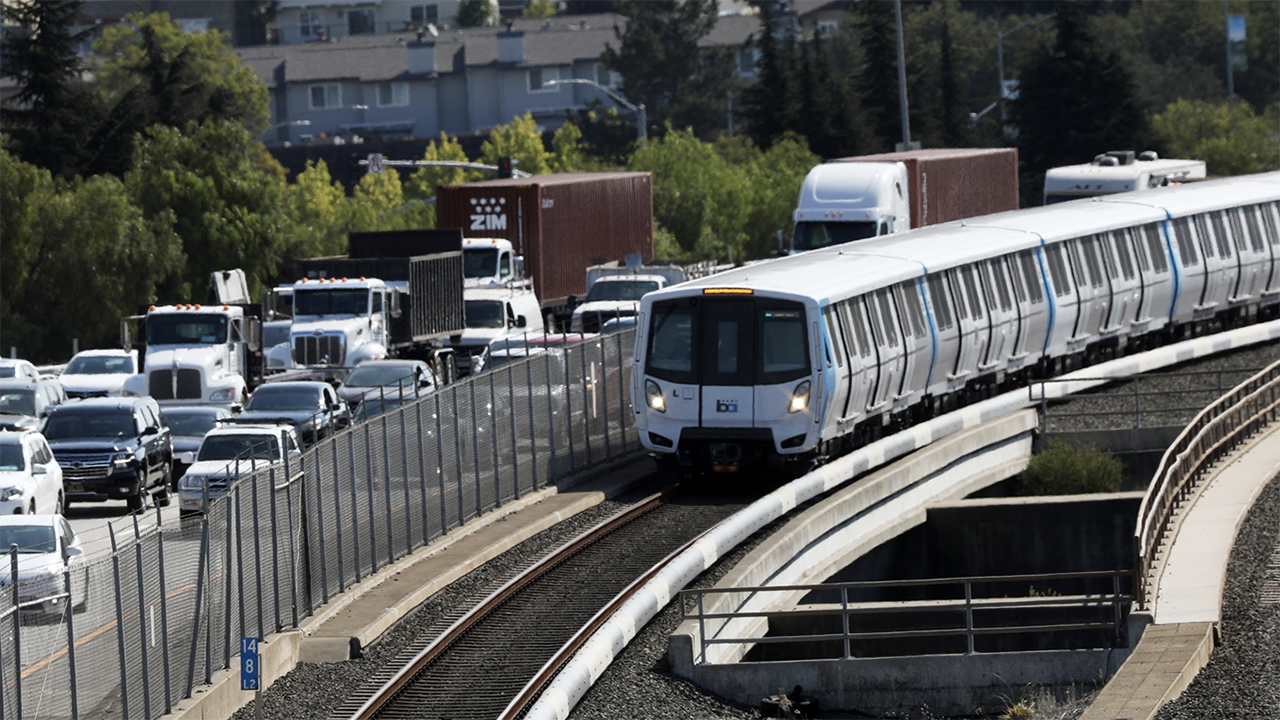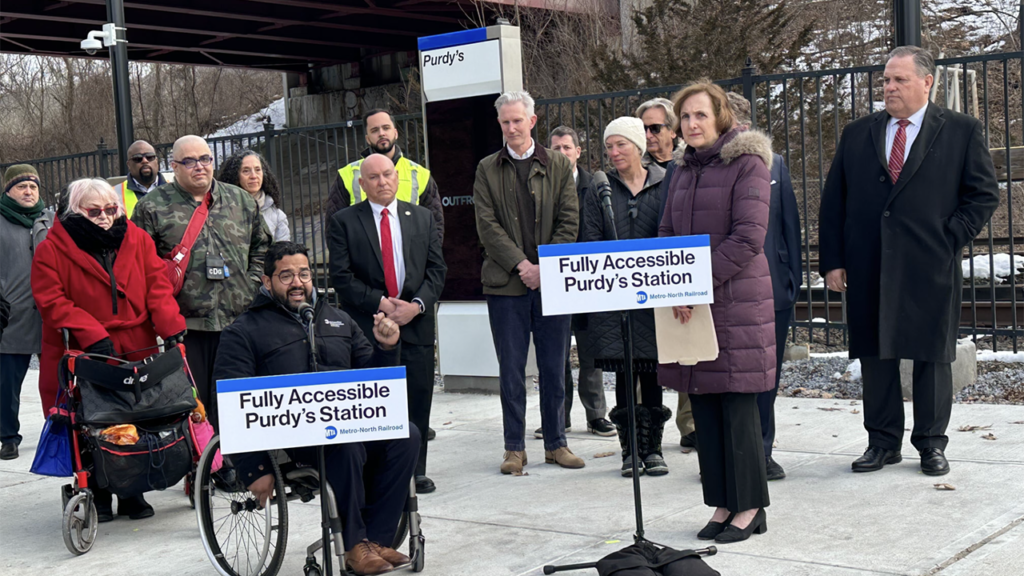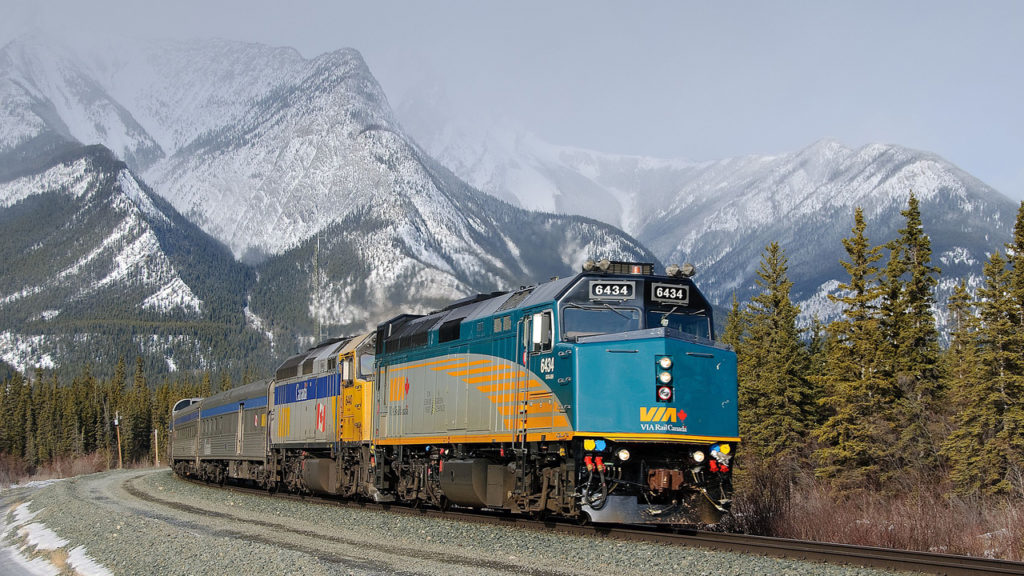
Transit Briefs: BART, Metro-North, VIA Rail, WMATA
Written by Marybeth Luczak, Executive Editor
BART’s overall customer satisfaction rating in the most recent Passenger Experience Survey (PES) reached 81%, which is 7% higher than the previous quarter, according to the transit agency. (BART Photograph)
San Francisco Bay Area Rapid Transit District (BART) reports rider satisfaction gains. Also, MTA Metro-North Railroad completes its third station-accessibility project in 2024; VIA Rail Canada calls on Ottawa to replace its long-distance fleet; and Washington Metropolitan Area Transit Authority (WMATA) increases police patrols on trains and buses.
BART
Customer satisfaction with BART is rising as overall ridership for second-quarter 2024 (October- December 2023) is up 9.2% over the prior-year period, the transit agency reported Feb. 23, upon the release of its latest Quarterly. Performance Report (see above).
BART’s overall customer satisfaction rating in the most recent Passenger Experience Survey (PES) reached 81%, which is 7% higher than the previous quarter, according to the transit agency. This is the third consecutive quarter PES results have shown that BART’s overall customer satisfaction rating has increased. PES is a year-round survey conducted on rapid transit trains on a near-daily basis, BART said.
It is the first time since the 2012 Customer Satisfaction Survey that BART has seen a customer satisfaction rating in the 80s. Overall satisfaction hovered between 84% and 86% from 2004 through 2012, before hitting a low of 56% in 2018, BART reported. In the transit agency’s latest Customer Satisfaction Survey in 2022, satisfaction was 67%. BART conducts the Customer Satisfaction survey every other year and the next survey will be fielded this fall.
This improvement in ratings comes as BART has advanced the implementation of its Safe and Clean Plan, which the agency said focuses on boosting the visible safety presence in the system and increasing staffing to clean trains and stations.
For the second consecutive quarter, the percentage of riders who say they have seen BART Police Department officers on their trip has reached a record high, according to BART’s new Quarterly Performance Report. This time, 20.3% of those questioned reported seeing BART’s “safety presence” on trains or in stations. That’s up from the previous record of 17% last quarter. The past two quarters have been the first in BART’s history where the percentage of riders who reported seeing BART PD exceeded the agency’s official goal of 12%.
Additionally, BART reported that its efforts “to be at the forefront of combating sexual harassment and gender-based violence continue to show results.” The percentage of riders saying they have experienced sexual harassment on BART has been declining since early 2023, the agency said. In the latest quarter, the percentage fell to 7%, which is down from a high of 10%. This improvement follows the launch of Phase II of the Not One More Girl campaign.
Metro-North

Metro-North has wrapped up work at the Purdy’s Station, making it the commuter railroad’s third station to have accessibility upgrades completed in 2024. Purdy’s Station, located on the Harlem Line in North Salem, N.Y., was already accessible with two elevators, but it is now fully accessible with the opening of a new elevator and connecting sidewalk. The new elevator travels between the parking lot and the Purdys Road/Route 116 overpass, and the sidewalk from the elevator to the existing station entrance is compliant with the Americans with Disabilities Act.
Initial improvements at Purdy’s Station began approximately five years ago when Metro-North, the New York State Department of Transportation (NYS DOT) and the town of North Salem agreed to work together to complete upgrades. The town used grant money to install sidewalks and traffic light controls, and the NYS DOT built an overpass to carry customers across Route 116 to the stairs that lead to Purdy’s Station.
Purdy’s takes its name from the family of Daniel Pardieus, who purchased large tracts of land in the area for farming in the late 18th century, according to Metro-North. His grandson Isaac Hart Purdy made an agreement with the New York & Harlem Railroad to establish a station and cattle yard, with the railroad arriving in summer 1847. The railroad paid a dollar for use of the land, in exchange for the guarantee of trains making “regular stops” at Purdy’s. “This ancient agreement saved train service in the mid-1950s when the New York Central Railroad, a Metro-North predecessor, sought to abandon or reduce service to the stop,” Metro-North reported. “Today, 69 trains stop there on weekdays and 50 on weekends.”
A second station replacing the original was built between 1890-1910 and a second track was added through Purdy’s to Croton Falls by 1907. The station building was demolished in 1974 as Interstate 684 was built between Goldens Bridge and Brewster, according to Metro-North.
Two other Harlem Line stations, Hartsdale and Scarsdale, have also been upgraded for accessibility this year. As part of its current capital plan, the Metropolitan Transportation Authority (MTA) is moving forward with accessibility upgrades at three more Metro-North stations, which are located in the Bronx. New station platforms, amenities, and two new elevators will be installed at the Woodlawn and Williams Bridge stations. The Botanical Garden Station will be rehabilitated, and station elevators will be upgraded.
“The MTA continues its lightning pace of making stations accessible across the entire network,” MTA Chair and CEO Janno Lieber said. “This is the fourth elevator that we’ve put into service along the Harlem Line in only the first two months of this year. With today’s [Feb. 22] announcement, 85% of Metro-North’s Harlem Line in Westchester County is now fully accessible—just two full-service stations left to go.”
VIA Rail

VIA Rail on Feb. 22 reported that its aging long-distance fleet used in Canadian and Ocean service needs to be replaced and unless Ottawa signs off on funding to procure new equipment, service could be reduced, according to CTV News Montreal. The cost is likely “several billion dollars,c and VIA Rail said the process must begin in 2024, as the current fleet won’t last past 2035, the media outlet reported.
CTV News Montreal visited VIA Rail’s maintenance center in Montreal, which services the long-distance trains.
“A major problem or a technical problem that can’t be solved on a daily basis, these cars are brought back here in the shop to repair and go back on service,” VIA Rail Vice President-Mechanical Services Andre Bouchard told the media outlet.
The overnight passenger trains—between Montreal and Halifax and between Toronto and Vancouver—serve the Indigenous communities and are a “lifeline,“ VIA Rail Senior Advisor of Public Affairs Jamie Orchard told CTV News Montreal. “Some of the communities, for example, Churchill, Manitoba, they have no road that gets there, so they get their groceries on these trains.”
She said the trains are “more than 70 years old in some cases and on average, trains run for about 25 years.”
Andre Bouchard told the media outlet that “[w]e extend at least three times—mostly three times—the expected life of this type of equipment.”
While talks between VIA Rail and Transport Canada are progressing, VIA Rail is awaiting Ottawa’s OK to begin the procurement process for new trains, according to the media outlet.
“The Government of Canada recognizes the importance of passenger rail service beyond the Québec City – Windsor Corridor and will continue to work to ensure its sustainability,” Transport Canada said in a written statement to CTV News Montreal.
VIA Rail in 2022 began acceptance testing of its first new trainset of 32 from Siemens Mobility that will serve the the Québec City – Windsor Corridor. Last summer, it started construction of the Toronto Maintenance Center, which will service the new fleet.
Further Reading:
- VIA Rail Adventures (First of a Series)
- VIA Rail Adventures (Second of a Series)
- VIA Rail Adventures (Third of a Series)
- Adventures on VIA Rail: The Last ‘Budd Train’
WMATA
WMATA is increasing the visibility of its Transit Police Department (Metro TPD/MTPD) in stations and incorporating more frequent patrols throughout the system “to ensure the safety and comfort of customers and employees,” it reported Feb. 21. Riders will see “special police officers walking trains and buses to provide a sense of security and address illegal activity in real time,” the transit agency said. Additionally, announcements made over train intercoms will alert customers that officers are on board and actively patrolling.
To supplement this effort, WMATA said it is using more than 30,000 cameras on buses, trains, and in stations, to help make it possible for MTPD to respond to incidents and emergencies faster. According to the transit agency, the cameras provide clear images that are often used by MTPD and other local law enforcement agencies to identify suspects and make arrests.
WMATA in 2023 increased patrols by 70% through partnerships with local law enforcement and special police officers, it said. Additionally, enforcement is up 300% overall, and new faregates in multiple locations have led to a decrease in fare evasion at those stations, according to the transit agency. As a result of these combined efforts, WMATA said it has seen a 14% decrease in crime. Meanwhile, Metrorail ridership on has increased 24% year-to-date, and Metrobus ridership is up 15%, it noted.
“As ridership increases, we want customers to see our officers and feel confident that we’re doing our part to keep them safe,” Metro Transit Police Chief Michael Anzallo said. “We hope customers will interact with the special police officers during their patrols and develop a rapport that promotes positive community connections.”
WMATA said it has also made lighting in stations brighter, added courtesy stops during late-night hours on Metrobuses to allow customers to get off closer to their destination, improved station signage, and added more prominent safety information. The transit agency is also rolling out a safety campaign on social media and digital signs throughout the region.



